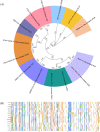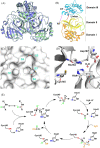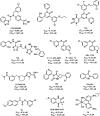The SARS-CoV-2 main protease (Mpro): Structure, function, and emerging therapies for COVID-19
- PMID: 35845352
- PMCID: PMC9283855
- DOI: 10.1002/mco2.151
The SARS-CoV-2 main protease (Mpro): Structure, function, and emerging therapies for COVID-19
Abstract
The main proteases (Mpro), also termed 3-chymotrypsin-like proteases (3CLpro), are a class of highly conserved cysteine hydrolases in β-coronaviruses. Increasing evidence has demonstrated that 3CLpros play an indispensable role in viral replication and have been recognized as key targets for preventing and treating coronavirus-caused infectious diseases, including COVID-19. This review is focused on the structural features and biological function of the severe acute respiratory syndrome coronavirus 2 (SARS-CoV-2) main protease Mpro (also known as 3CLpro), as well as recent advances in discovering and developing SARS-CoV-2 3CLpro inhibitors. To better understand the characteristics of SARS-CoV-2 3CLpro inhibitors, the inhibition activities, inhibitory mechanisms, and key structural features of various 3CLpro inhibitors (including marketed drugs, peptidomimetic, and non-peptidomimetic synthetic compounds, as well as natural compounds and their derivatives) are summarized comprehensively. Meanwhile, the challenges in this field are highlighted, while future directions for designing and developing efficacious 3CLpro inhibitors as novel anti-coronavirus therapies are also proposed. Collectively, all information and knowledge presented here are very helpful for understanding the structural features and inhibitory mechanisms of SARS-CoV-2 3CLpro inhibitors, which offers new insights or inspiration to medicinal chemists for designing and developing more efficacious 3CLpro inhibitors as novel anti-coronavirus agents.
Keywords: 3‐chymotrypsin‐like protease (3CLpro); SARS‐CoV‐2; broad‐spectrum anti‐coronavirus agents; β‐coronavirus 3CLpro inhibitor.
© 2022 The Authors. MedComm published by Sichuan International Medical Exchange & Promotion Association (SCIMEA) and John Wiley & Sons Australia, Ltd.
Conflict of interest statement
The authors declare they have no conflicts of interest.
Figures






Similar articles
-
Advances in research on 3C-like protease (3CLpro) inhibitors against SARS-CoV-2 since 2020.RSC Med Chem. 2022 Oct 27;14(1):9-21. doi: 10.1039/d2md00344a. eCollection 2023 Jan 25. RSC Med Chem. 2022. PMID: 36760740 Free PMC article. Review.
-
Discovery and mechanism of action of Thonzonium bromide from an FDA-approved drug library with potent and broad-spectrum inhibitory activity against main proteases of human coronaviruses.Bioorg Chem. 2023 Jan;130:106264. doi: 10.1016/j.bioorg.2022.106264. Epub 2022 Nov 9. Bioorg Chem. 2023. PMID: 36395603 Free PMC article.
-
Targeting zoonotic viruses: Structure-based inhibition of the 3C-like protease from bat coronavirus HKU4--The likely reservoir host to the human coronavirus that causes Middle East Respiratory Syndrome (MERS).Bioorg Med Chem. 2015 Sep 1;23(17):6036-48. doi: 10.1016/j.bmc.2015.06.039. Epub 2015 Jun 19. Bioorg Med Chem. 2015. PMID: 26190463 Free PMC article.
-
Inhibitors of Coronavirus 3CL Proteases Protect Cells from Protease-Mediated Cytotoxicity.J Virol. 2021 Jun 24;95(14):e0237420. doi: 10.1128/JVI.02374-20. Epub 2021 Jun 24. J Virol. 2021. PMID: 33910954 Free PMC article.
-
Targeting the Dimerization of the Main Protease of Coronaviruses: A Potential Broad-Spectrum Therapeutic Strategy.ACS Comb Sci. 2020 Jun 8;22(6):297-305. doi: 10.1021/acscombsci.0c00058. Epub 2020 May 27. ACS Comb Sci. 2020. PMID: 32402186 Review.
Cited by
-
Modeling of noncovalent inhibitors of the papain-like protease (PLpro) from SARS-CoV-2 considering the protein flexibility by using molecular dynamics and cross-docking.Front Mol Biosci. 2024 Mar 27;11:1374364. doi: 10.3389/fmolb.2024.1374364. eCollection 2024. Front Mol Biosci. 2024. PMID: 38601323 Free PMC article.
-
Sweet Basil (Ocimum basilicum L.)-A Review of Its Botany, Phytochemistry, Pharmacological Activities, and Biotechnological Development.Plants (Basel). 2023 Dec 13;12(24):4148. doi: 10.3390/plants12244148. Plants (Basel). 2023. PMID: 38140476 Free PMC article. Review.
-
Exploring the volatile metabolites of three Chorisia species: Comparative headspace GC-MS, multivariate chemometrics, chemotaxonomic significance, and anti-SARS-CoV-2 potential.Saudi Pharm J. 2023 May;31(5):706-726. doi: 10.1016/j.jsps.2023.03.012. Epub 2023 Mar 22. Saudi Pharm J. 2023. PMID: 37181141 Free PMC article.
-
In silico Study of Antiviral Activity of Polyphenol Compounds from Ocimum basilicum by Molecular Docking, ADMET, and Drug-Likeness Analysis.Adv Appl Bioinform Chem. 2023 Apr 26;16:37-47. doi: 10.2147/AABC.S403175. eCollection 2023. Adv Appl Bioinform Chem. 2023. PMID: 37131997 Free PMC article.
-
Identification of broad-spectrum Mpro inhibitors: a focus on high-risk coronaviruses and conserved interactions.J Enzyme Inhib Med Chem. 2025 Dec;40(1):2503961. doi: 10.1080/14756366.2025.2503961. Epub 2025 May 21. J Enzyme Inhib Med Chem. 2025. PMID: 40396609 Free PMC article.
References
Publication types
LinkOut - more resources
Full Text Sources
Miscellaneous
